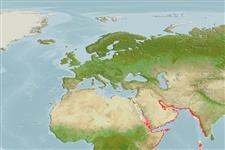Common names from other countries
>
Eupercaria/misc (Various families in series Eupercaria) >
Sparidae (Porgies)
Etymology: Acanthopagrus: Greek, akantha = thorn + Greek, pagros, a kind of fish (Ref. 45335); arabicus: Named for its type locality, the Arabian Sea including The Gulf..
Environment: milieu / climate zone / depth range / distribution range
ນິເວດວິທະຍາ
ສັດທະເລ; ລະດັບຄວາມເລິກ ? - 50 m (Ref. 11441). Tropical
Western Indian Ocean: from Duqum, southern Oman to Qatar, off the coasts of Kuwait (probably including Iran and Pakistan), to Trivandrum, south-western India.
ຂະໜາດ / ນ້ຳໜັກ / Age
Maturity: Lm ? range ? - ? cm
Max length : 34.5 cm SL ຕົວຜູ້/ບໍ່ມີເພດ; (Ref. 4606); common length : 30.0 cm TL ຕົວຜູ້/ບໍ່ມີເພດ; (Ref. 3507)
Short description
ຕົວທີ່ໃຊ້ໃນການຈຳແນກຊະນິດ | ສະລີລະວິທະຍາ | ການວັດແທກຮູບຮ່າງລັກສະນະພາຍນອກຂອງດິນ,ສັດ,ປາ…
ຄີ (ໜາມ)ແຂງຢູ່ຫຼັງປາ (ທັງໝົດ) : 11 - 12; ຄີຫຼັງຂອງປາ (ຄີອ່ອນ) (ທັງໝົດ) : 10 - 11; ຄີ(ໜາມ) ແຂງຢູ່ຄີກົ້ນປາ
ກຸ່ມປາກະດູກແຂງ
ຄວາມຖີ່ຂອງກຸ່ມຖ່າຍທອດພັນ
ປາທີ່ມີການເຄື່ອນຍ້າຍຈາກທະເລໄປຫານ້ຳຈືດ ແລະນ້ຳຈືດຫາທະເລ
ປາທີ່ມີການເຄື່ອນຍ້າຍຈາກທະເລແລະໄປໄຂ່ຢູ່ນ້ຳຈືດ
ຄີກົ້ນຂອງປາ
ສັດທີ່ມີກະດູກສັນຫັຼງ
ການຖ່າຍທອດທາງກຳມະພັນຈາກພໍ່ແມ່ຫາລູກ: 3; ຄີກົ້ນຂອງປາ: 8. This species is distinguished from its congeners by the following set of characters: deep body, 2.03-2.38 (mean 2.21); D XI,11 or XII,10; scale rows between fifth dorsal-fin spine base and lateral line 4 1/2, scale rows above lateral line 4 1/2-5 1/2, scale rows below 12 1/2-13 1/2; second anal-fin spine [17.5-24.2% (mean 20·5%) of SL], 1.31-1.52 (mean 1.39) in 2AS/3AS; pored lateral-line scales 42-45 (mean 43.9); first soft dorsal-fin ray slightly longer than last dorsal-fin spine; pelvic and anal fins vivid or strong yellow, lower caudal-fin lobe yellow (lighter or whitish yellow in larger adults); no black streaks proximally on inter-radial membranes between yellow anal-fin rays; clear black
blotches are usually absent just beneath inter-radial membranes between dorsal-fin rays but upper
dorsal-fin membrane often with darker margin; at the origin of lateral line a weak diffuse dark blotch usually covering first pored lateral-line scale, continuing as a dense dark shading over upper part of posterior opercle (Ref. 93743).
Feeds mainly on echinoderms, worms, crustaceans and mollusks. Mainly exploited by artisanal fisheries. Sold fresh in markets (Ref. 3507).
Life cycle and mating behavior
Maturities | ການສືບພັນ | Spawnings | Egg(s) | Fecundities | ຕົວອ່ອນ
Iwatsuki, Y., 2013. Review of the Acanthopagrus latus complex (Perciformes: Sparidae) with descriptions of three new species from the Indo-West Pacific Ocean. J. Fish Biol. 83(1):64-95. (Ref. 93743)
IUCN Red List Status (Ref. 130435)
CITES (Ref. 128078)
Not Evaluated
Human uses
ການປະມົງ: ເປັນສີນຄ້າ
ເຄື່ອງມື
Special reports
Download XML
ແຫຼ່ງອີນເຕີເນັດ
Estimates based on models
Preferred temperature (Ref.
115969): 24.6 - 29.3, mean 27.2 (based on 186 cells).
Phylogenetic diversity index (Ref.
82804): PD
50 = 0.5000 [Uniqueness, from 0.5 = low to 2.0 = high].
Bayesian length-weight: a=0.02512 (0.01448 - 0.04356), b=2.95 (2.81 - 3.09), in cm Total Length, based on LWR estimates for this species & Genus-body shape (Ref.
93245).
ຊັ້ນເຂດຮ້ອນ (Ref.
69278): 3.2 ±0.3 se; based on diet studies.
ຄວາມຢືດຢຸ່ນ (Ref.
120179): ຂະໜາດກາງ, ປະຊາກອນຕຳ່ສຸດທີ່ໃຊ້ເວລາສອງເທົ່າ 1.4 - 4.4 ປີ (Preliminary K or Fecundity.).
Fishing Vulnerability (Ref.
59153): Low to moderate vulnerability (32 of 100).
